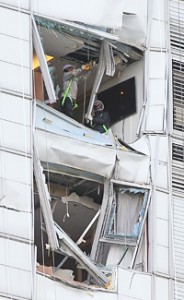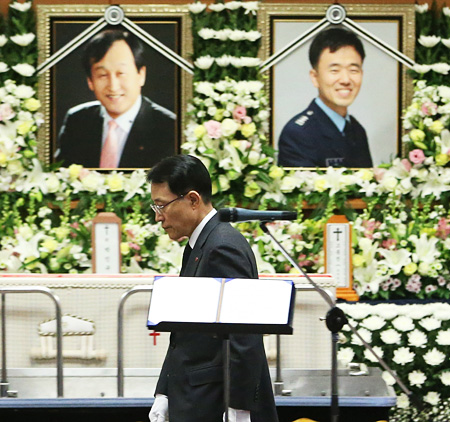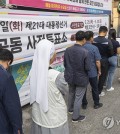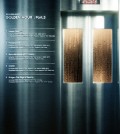- California Assembly OKs highest minimum wage in nation
- S. Korea unveils first graphic cigarette warnings
- US joins with South Korea, Japan in bid to deter North Korea
- LPGA golfer Chun In-gee finally back in action
- S. Korea won’t be top seed in final World Cup qualification round
- US men’s soccer misses 2nd straight Olympics
- US back on track in qualifying with 4-0 win over Guatemala
- High-intensity workout injuries spawn cottage industry
- CDC expands range of Zika mosquitoes into parts of Northeast
- Who knew? ‘The Walking Dead’ is helping families connect
Fears grow over high-rise apartment living
By Kim Jae-won

Workers engage in repair work Monday at a 38-story I’Part apartment in Samseong-dong, southern Seoul, into which a Sikorsky helicopter owned by LG Electronics crashed on Saturday, killing the two pilots onboard. Concerns over safety in high-rise apartments in the capital are rising after the accident.
(Yonhap)
The crash of a helicopter into an I’Park apartment in Samseong-dong, southern Seoul raised fears of living in high-rise apartments and office buildings in Seoul and Busan.
According to data from the Seoul Metropolitan Government, 16 high-rise buildings with 50 or more floors are in the capital city. Half of them are located in Gangnam District, the home for six Tower Palace apartments, the Korea World Trade Center and the Academy Suite.
In Yeongdeungpo District, there are three skyrocketing buildings, such as 63 Building, International Finance Center B and the headquarters of the Federation of Korean Industries.
Two buildings ― The Sharp Star City and The Classic 500 ― are in Gwangjin District in eastern Seoul. Guro, Seongdong and Yangcheon districts have one such building, respectively.
Residents in high-rise apartments expressed concerns over safety following the accident.
“We are still a bit nervous. I thought a war broke out at the time of the crash,” a housewife living in an apartment next to the I’Park apartment said.
However, there are currently no safety guidelines for helicopter flights within the city. Most helipads are within 3 to 4 kilometers of the buildings, meaning the possibility of such a crash recurring remains high.
“The high-rise buildings are vulnerable to such accidents. Sometimes sunshine reflecting on the windows of the buildings block pilots’ sights,” said a helicopter pilot of a Seoul fire station on condition of anonymity.
Additional the government does not regulate helicopters in the city.
The Ministry of Land, Infrastructure and Transport has no effective measures to supervise helicopters, therefore leaving city residents vulnerable to similar accidents.
Experts say that the government can reduce danger of crashes by regulating flights.
“We should impose tighter restrictions on helicopters. For instance, we can allow flights only when visibility distance is more than 5 kilometers, or require more efficient security equipment,” said Jeong Yun-sik, a professor at Jungwon University in Goesan, North Chungcheong Province.
Jeong said that the development of appropriate technologies will eventually solve these problems, while cautioning against the rush to impose limits on the heights of buildings because of the fear of crashes.
“We cannot say to remove the Mt. Nam because helicopters are in danger of crashing into it. We should develop technologies first, and then put some limitations on flights.”
Seoul City said that it will go all out to prevent aviation accidents in the city.
“This kind of accident should not take place any more in a city where high-rise buildings are densely situated,” Seoul Mayor Park Won-soon said. “The Seoul government plans to come out with measures to prevent recurrences of such accidents.”













